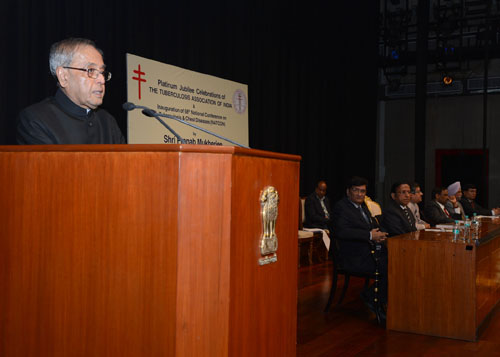Speech by the President of India, Shree Pranab Mukherjee at the Inauguration of National Conference on Tb and Allied Diseases (Natcon)
Rashtrapati Bhavan Auditorium, New Delhi : 23-02-2014
Download : Speeches ![]() (103.31 KB)
(103.31 KB)

Distinguished delegates, Ladies and Gentlemen
I am indeed happy to be amidst you this morning for the inauguration of the 68th National Conference on Tuberculosis and Chest Diseases organised under auspices of the Tuberculosis Association of India (TAI) in its Platinum Jubilee celebration year. At the very outset, I would like to extend my good wishes to the Tuberculosis Association of India and the National Institute of Tuberculosis and Respiratory Diseases (NITRD), New Delhi for organising this prestigious conference. The Tuberculosis Association of India, set up in 1939, is one of the oldest voluntary organisations having its affiliates all over the country.
As we are aware, India has the world's highest burden of tuberculosis. TB kills one person every two minutes in India or almost 750 people daily. Global TB control is unattainable without controlling the incidence of TB in India. Nearly 20 years after WHO’s declaration of Tuberculosis as a global public health emergency, major progress has been made towards attainment of the global targets defined in the context of the Millennium Development Goals. India has been an able partner in this progress. The Revised National Tuberculosis Control Programme (RNTCP) has become one of India’s largest public health achievements. The overall vision of RNTCP is "A TB free India”. There is compelling evidence now that the tide has, indeed, turned in case of TB. The burden of TB has begun to fall, and there are now fewer TB-related deaths each year than previous years.
It is heartening to note that the Ministry of Health and Family welfare (MoHFW) have developed an ambitious National Strategic Plan 2012-17 for TB Control, with the goal of universal access to early diagnosis and effective treatment. These goals seem achievable primarily because the TB programme has established a robust programme management infrastructure, focused on effective implementation, decentralizing patient-friendly services to impoverished and vulnerable sections of the population, and improving quality of care for all.
The endeavor should now be to aim for universal access focussing on improved diagnosis of TB patients through improving outreach, vigorously expanding case-finding efforts among vulnerable sections of the society, deploying better diagnostics, and extending services to patients diagnosed and treated in both the public and private sectors. The emphasis also has to be on improving patient-friendly access to high-quality treatment for all diagnosed cases of TB, including scaling-up treatment for Multi-Drug Resistant-TB nationwide. In that context, I am glad to see that the ‘National Rural Health Mission’ (NRHM) has expanded its reach and public health management capacity. The NRHM has improved service delivery infrastructure from the hospital to the village level, and has developed an army of community health workers and volunteers that can be leveraged to promptly detect symptomatic persons who suffer from TB.
The Ministry of Health and Family Welfare’s programme-based research for development and incorporation of innovations into effective programme practice is similarly noteworthy. The prohibition on manufacture, sale, distribution and use of sero-diagnostic test kits for tuberculosis will have far reaching policy implications and would help streamline TB diagnostics in India. TB is now a notifiable disease. It mandates all healthcare providers to notify every TB case, diagnosed or treated, to local authorities on a regular basis. The Central TB Division in collaboration with National Informatics Centre has developed a case-based web platform - ‘Nikshay’, which is now being scaled up nationally. This will enable better surveillance and tracking of TB cases and shall prove to be an effective programme management tool.
I must also stress that no national level campaign is successful without the active participation of voluntary organisations. The role played by the Tuberculosis Association of India in supplementing the Government’s efforts in prevention and control of TB is indeed praiseworthy. It has been publishing a quarterly, the ‘Indian Journal of Tuberculosis’ exclusively devoted to the cause of TB. It also organizes a National level Conference on Tuberculosis every year and this year’s Conference commemorating the Platinum Jubilee is being organized at Delhi in association with the National Institute of Tuberculosis and Respiratory Diseases (NITRD). The annual TB Seal Campaign is a novel way of spreading awareness about tuberculosis.
While wishing both these organisations all success for the Conference, I would urge all stakeholders to contribute to this noble cause so that the scourge of Tuberculosis ceases to be a public health problem in India and every citizen of our country goes on to become a productive member of society, participating actively in nation building.
Non-tubercular respiratory diseases like asthma, COPD, lung cancer, silicosis, health hazards of smoking are emerging as an additional burden to public health services in India. Conferences like the NATCON could be the best fora to discuss these conditions and formulate recommendations to guide national policies for prevention and control of these diseases. Let us commit ourselves to continue to do our best for instituting health care systems in the country which are equitable, affordable and accessible by all sections of the society.
I am confident that when we put our hearts and minds together we shall be able to build an India free of Tuberculosis and other preventable diseases. With these few words, I wish the Conference and its deliberations all the very best.
Jai Hind!
